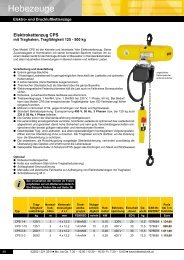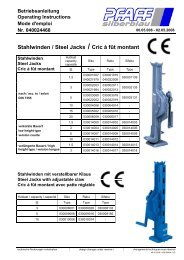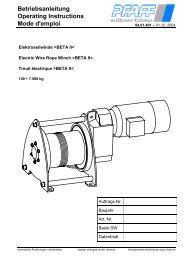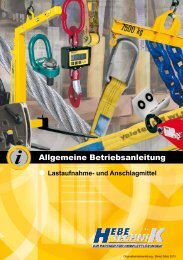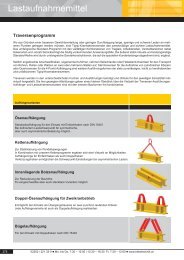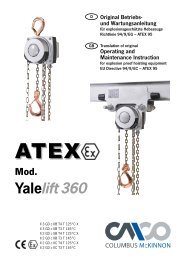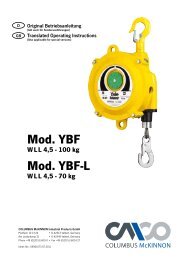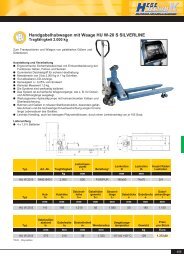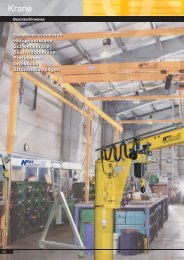Manual de operación pinzas para lámina TBL - Tecniyale
Manual de operación pinzas para lámina TBL - Tecniyale
Manual de operación pinzas para lámina TBL - Tecniyale
Create successful ePaper yourself
Turn your PDF publications into a flip-book with our unique Google optimized e-Paper software.
DEENFRESOriginal Betriebsanleitung(Gilt auch für Son<strong>de</strong>rausführungen)Translated Operating Instructions(Also applicable for special versions)Traduction <strong>de</strong> mo<strong>de</strong> d’emploi(Cela s‘applique aussi aux autres versions)Instrucciones <strong>de</strong> Servicio Traducida(También valido <strong>para</strong> garras con diseňo especial)BlechgreiferPlate clampPinces à tôleGarra verticalMod. <strong>TBL</strong>WLL 500 - 30.000 kgCOLUMBUS McKINNON Industrial Products GmbHPostfach 10 13 24 • D-42513 Velbert, GermanyAm Lin<strong>de</strong>nkamp 31 • D-42549 Velbert, GermanyPhone +49 (0) 20 51/600-0 • Fax +49 (0) 20 51/600-127I<strong>de</strong>nt.-No.: 09901000/10.2011
gen (z.B. in <strong>de</strong>r Galvanik) können kürzerePrüfi ntervalle notwendig machen.Re<strong>para</strong>turarbeiten dürfen nur von Fachwerkstätten,die Original Yale Ersatzteile verwen<strong>de</strong>n,durchgeführt wer<strong>de</strong>n. Die Prüfung (imWesentlichen Sicht- und Funktionsprüfung) hatsich auf die Vollständigkeit und Wirksamkeit<strong>de</strong>r Sicherheitseinrichtungen sowie auf <strong>de</strong>nZustand <strong>de</strong>s Gerätes, <strong>de</strong>r Tragmittel, <strong>de</strong>rAusrüstung und <strong>de</strong>r Tragkonstruktion hinsichtlichBeschädigung, Verschleiß, Korrosiono<strong>de</strong>r sonstigen Verän<strong>de</strong>rungen zu erstrecken.Die Inbetriebnahme und die wie<strong>de</strong>rkehren<strong>de</strong>nPrüfungen müssen dokumentiert wer<strong>de</strong>n (z.B.in <strong>de</strong>r CMCO-Werksbescheinigung).Auf Verlangen <strong>de</strong>r Berufsgenossenschaft sinddie Ergebnisse <strong>de</strong>r Prüfungen und die sachgemäßeRe<strong>para</strong>turdurchführung nachzuweisen.Ist das Hebezeug (ab 1 t Hubgewicht) an o<strong>de</strong>rin einem Fahrwerk eingebaut, o<strong>de</strong>r wird mit<strong>de</strong>m Hebezeug eine gehobene Last in eineo<strong>de</strong>r mehrere Richtungen bewegt, wird dieAnlage als Kran betrachtet und die Prüfungensind gemäß BGV D6-Krane durchzuführen.Lackbeschädigungen sind auszubessern, umKorrosion zu vermei<strong>de</strong>n. Alle Gelenkstellenund Gleitfl ächen sind leicht einzuölen. Bei starkerVerschmutzung ist das Gerät zu reinigen.PRÜFUNG VOR ARBEITSBEGINN- Es ist darauf zu achten, dass die Oberfl ächen<strong>de</strong>s Hebegutes, wo das Lastaufnahmemittelangeschlagen wird, möglichst fett-, farb-,schmutz-, zun<strong>de</strong>r- und beschichtungsfreisind, so dass <strong>de</strong>r Kontakt <strong>de</strong>r Zähne zumHebegut nicht behin<strong>de</strong>rt wird.- Fest- und Klemmbacke (Fig. 6) auf Verschleißund Mängel prüfen. Bei<strong>de</strong> Backen müssenein sauberes Profi l besitzen.- Das gesamte Lastaufnahmemittel ist aufBeschädigungen, Risse o<strong>de</strong>r Verformungenhin zu überprüfen.- Das Lastaufnahmemittel muss sich leichtgängigöff nen und schließen lassen.- Zugfe<strong>de</strong>r überprüfen (Fig. 6). Befi n<strong>de</strong>t sich<strong>de</strong>r Schließhebel in <strong>de</strong>r Stellung „Zu“, mussdiese eine <strong>de</strong>utlich spürbare Fe<strong>de</strong>rkraftaufweisen, wenn man auf die Aufhängeösedrückt.GEBRAUCH DESLASTAUFNAHMEMITTELS<strong>TBL</strong> 0,5 (500 kg)Das Lastaufnahmemittel mit seinem Maulbis zum Anschlag auf das Hebegut schieben.Durch die Fe<strong>de</strong>rvorspannkraft wird die Klemmbackegegen das Hebegut gedrückt. Dadurchist gewährleistet, dass das aufgesetzte Lastaufnahmemittelinfolge dieser Fe<strong>de</strong>rvorspannkraftauch ohne Zugbelastung am Hebegutangeklemmt bleibt. Das Hebegut kann nunangehoben und transportiert wer<strong>de</strong>n.Nach<strong>de</strong>m <strong>de</strong>r Arbeitsvorgang been<strong>de</strong>t wur<strong>de</strong>,ist das Tragmittel soweit herunterzufahren,dass das Lastaufnahmemittel entlastet bzw.die Aufhängeöse völlig frei beweglich ist. Nunkann das Lastaufnahmemittel vom Hebegutgezogen wer<strong>de</strong>n.Ab <strong>TBL</strong> 1,0 (1.000 kg)In <strong>de</strong>r Stellung „AUF“ <strong>de</strong>s Hebels befi n<strong>de</strong>tsich die Klemmbacke in <strong>de</strong>r Öff nungsstellungund ist arretiert. In dieser Stellung ist dasLastaufnahmemittel mit seinem Maul biszum Anschlag auf das Hebegut zu schieben.Durch Umlegen <strong>de</strong>s Hebels auf die Stellung„ZU“ wird die Klemmbacke freigegeben. Durchdie Fe<strong>de</strong>rvorspannkraft wird die Klemmbackegegen das Hebegut gedrückt. Dadurch ist gewährleistet,dass das aufgesetzte Lastaufnahmemittelinfolge eben dieser Fe<strong>de</strong>rvorspannkraft,auch ohne Zugbelastung am Hebegutangeklemmt bleibt. Das Hebegut kann nunangehoben und transportiert wer<strong>de</strong>n (Fig. 5).Nach<strong>de</strong>m <strong>de</strong>r Arbeitsvorgang been<strong>de</strong>t wur<strong>de</strong>,ist das Tragmittel soweit herunterzufahren,dass das Lastaufnahmemittel entlastet bzw.die Aufhängeöse völlig frei beweglich ist. Nunkann <strong>de</strong>r Hebel wie<strong>de</strong>r in die Ausgangsposition„AUF“ gedreht und das Lastaufnahmemittelvom Hebegut gezogen wer<strong>de</strong>n.HinweisSollte sich <strong>de</strong>r Hebel nicht umlegen lassen,kann durch einen leichten Schlag mit einemHammer auf die Aufhängeöse das Lastaufnahmemittelgelöst wer<strong>de</strong>n.PRÜFUNG/WARTUNGLaut bestehen<strong>de</strong>n nationalen/internationalenUnfallverhütungs- bzw. Sicherheitsvorschriftenmüssen Hebezeuge• gemäß <strong>de</strong>r Gefahrenbeurteilung <strong>de</strong>sBetreibers,• vor <strong>de</strong>r ersten Inbetriebnahme,• vor <strong>de</strong>r Wie<strong>de</strong>rinbetriebnahme nachStilllegung,• nach grundlegen<strong>de</strong>n Än<strong>de</strong>rungen,• jedoch min<strong>de</strong>stens 1 x jährlich durch einebefähigte Person geprüft wer<strong>de</strong>n.ACHTUNG: Die jeweiligen Einsatzbedingungen(z.B. in <strong>de</strong>r Galvanik) können kürzerePrüfi ntervalle notwendig machen.Re<strong>para</strong>turarbeiten dürfen nur von Fachwerkstätten,die Original Yale Ersatzteile verwen<strong>de</strong>n,durchgeführt wer<strong>de</strong>n. Die Prüfung (imWesentlichen Sicht- und Funktionsprüfung) hatsich auf die Vollständigkeit und Wirksamkeit<strong>de</strong>r Sicherheitseinrichtungen sowie auf <strong>de</strong>nZustand <strong>de</strong>s Gerätes, <strong>de</strong>r Tragmittel, <strong>de</strong>rAusrüstung und <strong>de</strong>r Tragkonstruktion hinsichtlichBeschädigung, Verschleiß, Korrosiono<strong>de</strong>r sonstigen Verän<strong>de</strong>rungen zu erstrecken.Die Inbetriebnahme und die wie<strong>de</strong>rkehren<strong>de</strong>nPrüfungen müssen dokumentiert wer<strong>de</strong>n (z.B.in <strong>de</strong>r CMCO-Werksbescheinigung).Auf Verlangen <strong>de</strong>r Berufsgenossenschaft sinddie Ergebnisse <strong>de</strong>r Prüfungen und die sachgemäßeRe<strong>para</strong>turdurchführung nachzuweisen.Lackbeschädigungen sind auszubessern, umKorrosion zu vermei<strong>de</strong>n. Alle Gelenkstellenund Gleitfl ächen sind leicht einzuölen. Bei starkerVerschmutzung ist das Gerät zu reinigen.Re<strong>para</strong>turen dürfen nur von Fachwerkstätten,die Original TIGRIP Ersatzteileverwen<strong>de</strong>n, durchgeführt wer<strong>de</strong>n.Nach einer erfolgten Re<strong>para</strong>tur sowie nachlängerer Standzeit ist das Hebezeug vor <strong>de</strong>rWie<strong>de</strong>rinbetriebnahme erneut zu prüfen.Die Prüfungen sind vom Betreiber zuveranlassen.TRANSPORT, LAGERUNG, AUSSERBE-TRIEBNAHME UND ENTSORGUNGBeim Transport <strong>de</strong>s Gerätes sind folgen<strong>de</strong>Punkte zu beachten:• Gerät nicht stürzen o<strong>de</strong>r werfen, immervorsichtig absetzen.• Geeignete Transportmittel verwen<strong>de</strong>n.Diese richten sich nach <strong>de</strong>n örtlichenGegebenheiten.Bei <strong>de</strong>r Lagerung o<strong>de</strong>r <strong>de</strong>r vorübergehen<strong>de</strong>nAußerbetriebnahme <strong>de</strong>s Gerätessind folgen<strong>de</strong> Punkte zu beachten:• Das Gerät an einem sauberen, trockenenund möglichst frostfreien Ort lagern.• Das Gerät vor Verschmutzung, Feuchtigkeitund Schä<strong>de</strong>n durch eine geeignete Ab<strong>de</strong>ckungschützen.• Soll das Gerät nach <strong>de</strong>r Außerbetriebnahmewie<strong>de</strong>r zum Einsatz kommen, ist es zuvoreiner erneuten Prüfung durch eine befähigtePerson zu unterziehen.Entsorgung:Nach Außerbetriebnahme sind die Teile <strong>de</strong>sGerätes und gegebenenfalls die Betriebsstoff e(Öle, Fette, etc.) entsprechend <strong>de</strong>n gesetzlichenBestimmungen <strong>de</strong>r Wie<strong>de</strong>rverwertungzuzuführen bzw. zu entsorgen.Weitere Informationen und Betriebsanleitungenzum Download sind unterwww.cmco.eu zu fin<strong>de</strong>n!3 von 16
Paint damage should be touched up in or<strong>de</strong>r toavoid corrosion. All joints and sliding surfacesshould be slightly oiled. In the case of heavycontamination, the unit must be cleaned.INSPECTIONS BEFORE STARTINGWORK- Ensure that the surface of the load, in thelocation where the load lifting attachment isapplied, is free from grease, paint, contaminationand scale and is not coated, so thatthe teeth can make good contact with thesurface of the load.- Check the fi xed jaw and the clamping jaw(Fig. 6) for wear and <strong>de</strong>fects. Both jaws musthave clean profi les.- Check the complete load lifting attachmentfor damage, cracks or <strong>de</strong>formations.- The load lifting attachment must open andclose easily and freely.- Check the spring (Fig. 6). When the lever isin the “Close” position, the spring must havea noticeable spring pressure force when thesuspension eye is <strong>de</strong>pressed.USAGE OF THE LOAD LIFTINGATTACHMENT<strong>TBL</strong> 0,5 (500 kg)Push the load lifting attachment onto the loaduntil the load has fully entered the mouth ofthe clamp. The clamping jaw is fi rmly pressedagainst the load by spring pressure force.This ensures that the applied load lifting attachmentremains clamped to the load as aresult of the spring pressure force also withoutany pulling force. The load can now be liftedand transported.At the end of the transport operation, thesuspension (e. g. hook, shackle, etc.) mustbe lowered until the load lifting attachment iscompletely load-free and/or the suspensioneye can be moved freely. The load liftingattachment can be removed from the load.From <strong>TBL</strong> 1,0 (1.000 kg)In the “OPEN” position of the lever, the clampingjaw is locked in the open position. In thisposition, push the load lifting attachment ontothe load until the load has fully entered themouth of the clamp. By switching the leverto the “CLOSE” position, the clamping jaw isreleased. The clamping jaw is fi rmly pressedagainst the load by spring pressure force. Thisensures that the applied load lifting attachmentremains clamped to the load preciselyas a result of the spring pressure force alsowithout any pulling force. The load can nowbe lifted and transported (Fig. 5). At the endof the transport operation, the suspension(e. g. hook, shackle, etc.) must be lowereduntil the load lifting attachment is completelyload-free and/or the suspension eye can bemoved freely. The lever can now be switched tothe “OPEN” position again and the load liftingattachment can be removed from the load.NoteIf the lever cannot be switched over, a light tapon the suspension eye with a hammer shouldrelease the load lifting attachment.INSPECTION / MAINTENANCEAccording to national and international acci<strong>de</strong>ntprevention and safety regulations hoistingequipment must be inspected:• in accordance with the risk assessment ofthe operating company,• prior to initial operation,• before the unit is put into service againfollowing a shut down,• after substantial changes,• however, at least once per year, by acompetent person.ATTENTION: Actual operating conditions(e.g. operation in galvanizing facilities) candictate shorter inspection intervals.Repair work may only be carried out by a specialistworkshop that uses original Yale spareparts. The inspection (mainly consisting of avisual inspection and a function check) must<strong>de</strong>termine that all safety <strong>de</strong>vices are completeand fully operational and cover the conditionof the unit, suspension, equipment and supportingstructure with regard to damage, wear,corrosion or any other alterations.Initial operation and recurring inspectionsmust be documented (e.g. in the CMCO workscertifi cate of compliance).If required by the Industrial Employers’ MutualInsurance Association, the results of inspectionsand appropriate repairs must be verifi ed.Paint damage should be touched up in or<strong>de</strong>r toavoid corrosion. All joints and sliding surfacesshould be slightly oiled. In the case of heavycontamination, the unit must be cleaned.Repairs may only be carried out byspecialist workshops that use originalTIGRIP spare parts.After repairs have been carried out andafter exten<strong>de</strong>d periods of non-use, the hoistmust be inspected again before it is put intoservice again.The inspections have to be initiated bythe operating company.TRANSPORT, STORAGE, TAKE OUT OFSERVICE AND DISPOSALObserve the following for transportingthe unit:• Do not drop or throw the unit, always <strong>de</strong>positit carefully.• Use suitable transport means. These<strong>de</strong>pend on the local conditions.Observe the following for storing or temporarilytaking the unit out of service:• Store the unit at a clean and dry place wherethere is no frost.• Protect the unit against contamination,humidity and damage by means of asuitable cover.• If the unit is to be used again after it hasbeen taken out of service, it must fi rst beinspected again by a competent person.Disposal:After taking the unit out of service, recycleor dispose of the parts of the unit and, ifapplicable, the operating material (oil, grease,etc.) in accordance with the legal regulations.Further information and operatinginstructions are to be found atwww.cmco.eu5 von 16
FrançaisINTRODUCTIONLes produits <strong>de</strong> CMCO Industrial ProductsGmbH ont été conçus en respectant l’état <strong>de</strong>l’art et les normes validées. Néanmoins uneutilisation incorrecte du produit peut entraîner<strong>de</strong>s dommages corporelles irréversibles àl’utilisateur et/ou <strong>de</strong>s dommages au palan oua un tiers. L’entreprise utilisatrice du produitest seul responsable <strong>de</strong> la formation correcteet professionnelle <strong>de</strong>s opérateurs. Ainsi, tousles utilisateurs doivent lire attentivementles instructions <strong>de</strong> mise en service avantla 1ère utilisation. Ces instructions doiventpermettre à l’utilisateur <strong>de</strong> se familiariser avecle produit et <strong>de</strong> l’utiliser au maximum <strong>de</strong> sescapacités. Les instructions <strong>de</strong> mise en servicecontiennent <strong>de</strong>s informations importantes surla manière d’utiliser le palan <strong>de</strong> façon sûre,correcte et économique.Agir conformément à ces instructions permetd’éviter les dangers, réduire les coûts <strong>de</strong>ré<strong>para</strong>tion, réduire les temps d’arrêt et augmenterla fi abilité et la durée <strong>de</strong> vie du palan.Le manuel d’instructions doit toujours êtredisponible sur le lieu d’utilisation du palan.En complément <strong>de</strong>s instructions <strong>de</strong> miseen service et <strong>de</strong>s réglementations relativesà la prévention <strong>de</strong>s acci<strong>de</strong>nts, il faut tenircompte <strong>de</strong>s règles en vigueur en matière <strong>de</strong>sécurité du travail et professionnelles danschaque pays. Le personnel responsable <strong>de</strong>sopérations <strong>de</strong> maintenance et ré<strong>para</strong>tion duproduit doivent avoir lu, compris et suivi les instructions.Les mesures <strong>de</strong> protection indiquéesfourniront seulement la sécurité nécessaire, sile produit est utilisé correctement et installéet/ou révisé selon les instructions. L’entrepriseutilisatrice doit assurer le fonctionnement sûret sans panne du produit.UTILISATION CORRECTE- Cet appareil <strong>de</strong> levage est <strong>de</strong>stiné à larotation <strong>de</strong>s charges jusqu’à 180° et autransport individuel <strong>de</strong> tôles et plaquesd’acier en position verticale dans les limites<strong>de</strong> la capacité <strong>de</strong> préhension indiquée sur laplaque signalétique (Tab. 1).N’importe quelle utilisation différenteou excessive est considérée commeincorrecte. Columbus McKinnonIndustrial Products GmbH ne pourraêtre tenu responsable en cas <strong>de</strong>dommage durant une telle utilisation.Le risque est pris uniquement parl’utilisateur final.- Cet appareil <strong>de</strong> levage est adapté à toutesles charges en acier qui s’insèrent complè-6 von 16FRtement dans les mâchoires <strong>de</strong> serrage etdont la dureté <strong>de</strong> la surface ne dépasse pasHRC 30.- La capacité <strong>de</strong> charge (WLL) indiquée surl’appareil est le poids <strong>de</strong> charge maximalautorisé.- La charge minimum doit correspondre à10 % <strong>de</strong> la capacité <strong>de</strong> charge indiquée.Dans le cas contraire, la force <strong>de</strong> serragepermettant un transport en toute sécuriténe sera pas atteinte.- Il est interdit <strong>de</strong> passer ou <strong>de</strong> s’arrêter sousune charge suspendue.- Les charges ne doivent pas être suspendues,accrochées ou laissées sans surveillancetrop longtemps.- L’utilisateur doit déclencher le déplacement<strong>de</strong> la charge uniquement après s’être assuréque la charge est bien fi xée et que personnene se trouve dans la zone <strong>de</strong> danger.- L’utilisateur doit s’assurer que l’appareil<strong>de</strong> levage (crochet,manille...) est fi xé <strong>de</strong>façon à ce que ni celui-ci ni la charge, nereprésentent <strong>de</strong> danger pour l’utilisateur oule personnel.- Consulter le fabricant avant d’utiliserl’appareil dans <strong>de</strong>s conditions particulières(environnement très humi<strong>de</strong>, salé, corrosif,alcalin) ou pour la manipulation <strong>de</strong> matièresdangereuses (mélanges en fusion, matériauxradioactifs).- L’appareil peut être utilisé dans une températureambiante comprise entre –40 °C et+100 °C. En cas <strong>de</strong> conditions extrêmes,contacter le fabricant.- S’il est nécessaire <strong>de</strong> transporter <strong>de</strong>splaques <strong>de</strong> métal ou <strong>de</strong> profi lés plus longues,nous recommandons l’utilisation <strong>de</strong> <strong>de</strong>uxappareils <strong>de</strong> levage et d’un palonnier afi nd’empêcher le balancement <strong>de</strong> la charge etles forces <strong>de</strong> traction latérales.- La charge doit toujours être transportéelentement, avec pru<strong>de</strong>nce et près du sol.- Lors du déchargement, vérifi er que le crochetdu palan n’appuie pas sur l’appareil <strong>de</strong>levage. Le poids du crochet du palan risque<strong>de</strong> déclencher l’ouverture <strong>de</strong> l’appareil <strong>de</strong>levage.- Utiliser uniquement <strong>de</strong>s crochets <strong>de</strong> palanmunis d’un loquet <strong>de</strong> sécurité.- L’œillet <strong>de</strong> suspension <strong>de</strong> l’appareil doit avoirassez <strong>de</strong> place dans le crochet et s’articulerlibrement.- Si l’appareil est défaillant, cesser immédiatement<strong>de</strong> l’utiliser.UTILISATIONS INCORRECTES(Liste non complète)- Ne pas dépasser la capacité <strong>de</strong> chargemaximale (WLL).- Seules les charges comprises dans lacapacité <strong>de</strong> préhension indiquée peuventêtre soulevées.- Le poids <strong>de</strong> charge minimum ne doit pasêtre inférieur à 10 % <strong>de</strong> la capacité <strong>de</strong> chargeindiquée sinon la force <strong>de</strong> serrage nécessaireà un transport en toute sécurité ne sera pasatteinte.- Toute modifi cation <strong>de</strong> l’appareil <strong>de</strong> levageest interdite.- Il est interdit d’utiliser l’appareil <strong>de</strong> levagepour le transport <strong>de</strong> personnes.- Lors du transport <strong>de</strong> la charge, vérifierqu’elle ne se balance pas (Fig. 1) et qu’ellene rentre pas en contact avec d’autresobjets.- L’appareil <strong>de</strong> levage ne peut transporterqu’une seule plaque <strong>de</strong> métal à la fois(Fig. 2).- Il est interdit d’exercer <strong>de</strong>s forces <strong>de</strong> tractionsur les angles au niveau du système <strong>de</strong> rotation<strong>de</strong> l’œillet <strong>de</strong> suspension <strong>de</strong> l’appareil(Fig. 3).- Insérer entièrement la charge dans lesmâchoires <strong>de</strong> serrage (Fig. 4).- Ne pas utiliser <strong>de</strong> levier <strong>de</strong> verrouillage pourfi xer et lever <strong>de</strong>s charges.- Ne pas laisser tomber l’appareil <strong>de</strong> haut.- L’appareil ne doit pas être utilisé dans uneatmosphère explosible.INSPECTION AVANT MISE EN SERVICEEn concordance avec les réglementationsnationales et internationales relatives à laprévention <strong>de</strong>s acci<strong>de</strong>nts et <strong>de</strong>s règles <strong>de</strong>sécurité, les appareils <strong>de</strong> levage doivent êtreinspectés :• conformément à l’évaluation <strong>de</strong>s risques enfonction <strong>de</strong> l’entreprise utilisatrice,• avant la première utilisation,• avant la mise en service <strong>de</strong> l’appareil aprèsun arrêt d’utilisation,• après <strong>de</strong>s modifi cations substantielles,• au moins une fois par an par une personnecompétente.ATTENTION: Si les conditions d’utilisation(ex : utilisation en atmosphère agressive)sont plus diffi ciles, les inspections doiventêtre plus fréquentes.Les ré<strong>para</strong>tions doivent être eff ectuées par unatelier agréé, qui utilise <strong>de</strong>s pièces détachéesYale d’origine. Les composants <strong>de</strong> l’appareildoivent être vérifi és (généralement la vérifi -cation consiste en une inspection visuelle etfonctionnelle) quant à leurs défauts, usure,corrosion ou autres irrégularités, et tous lesdispositifs <strong>de</strong> sécurité doivent être testés quantà leur bon état et effi cacité.Les inspections initiales et suivantes doiventêtre enregistrées (ex : sur la documentationfournis par CMCO).
Si une assurance d’entreprise le <strong>de</strong>man<strong>de</strong>, lesrésultats <strong>de</strong>s inspections et <strong>de</strong>s ré<strong>para</strong>tionsdoivent être vérifi és. Si le palan (à partir <strong>de</strong>1 t <strong>de</strong> capacité) est monté sur ou incorporédans un chariot ou si le palan est utilisé pourdéplacer une charge levée dans une ou plusieursdirections, l’installation est considéréecomme un pont et les inspections doivent êtreréalisées selon la norme BGV D6.Les endroits où la peinture est détériorée ouabsente doivent être repeints afi n d’éviterles risques <strong>de</strong> corrosion. Tous les joints etles points <strong>de</strong> liaison doivent être légèrementlubrifi ées. En cas <strong>de</strong> contamination, l’appareildoit être entièrement décontaminé.INSPECTION AVANT DE COMMENCERÀ TRAVAILLER- Vérifi er que la surface <strong>de</strong> la charge surlaquelle l’appareil <strong>de</strong> levage est fi xé ne présentepas <strong>de</strong> trace <strong>de</strong> graisse, <strong>de</strong> peinture,<strong>de</strong> salissure, <strong>de</strong> craquelure et n’est pasenduite afi n que les fourches puissent yadhérer correctement.- Contrôler l’usure et la détérioration <strong>de</strong>smâchoires fi xes et <strong>de</strong>s mâchoires <strong>de</strong> serrage(Fig. 6). Les profi lés doivent être propres.- Contrôler la détérioration, les craquelures oules déformations <strong>de</strong> l’appareil <strong>de</strong> levage.- L’appareil <strong>de</strong> levage doit s’ouvrir et se fermerfacilement et librement.- Vérifi ez le ressort (Fig. 6). Si le levier est enposition «fermée», le ressort doit exercerune certaine pression lorsque l’oeillet <strong>de</strong>suspension est enfoncé.FIXATION DE LA CHARGE<strong>TBL</strong> 0,5 (500 kg)Insérer complètement la charge dans les mâchoires<strong>de</strong> la pince. Les mâchoires <strong>de</strong> serragemaintiennent fermement la charge sous l’eff etdu ressort. Grâce à ce dispositif, la charge estfermement maintenue sur l’appareil <strong>de</strong> levagegrâce à la pression exercée par le ressort sansforce supplémentaire. La charge peut maintenantêtre soulevée et transportée.A partir <strong>de</strong> <strong>TBL</strong> 1,0 (1.000 kg)Lorsque le levier est en position «OPEN» (ouverte),la mâchoire <strong>de</strong> serrage est verrouilléeen position ouverte. Insérer complètementla charge dans les mâchoires <strong>de</strong> la pince.En plaçant le levier sur la position «CLOSE»(fermée), la mâchoire se déverrouille. Lesmâchoires <strong>de</strong> serrage sont fermement maintenuessur la charge sous pression du ressort.Grâce à ce dispositif, la charge est fermementmaintenue sur l’appareil <strong>de</strong> levage grâce àla pression exercée par le ressort sans forcesupplémentaire. La charge peut maintenantêtre soulevée et transportée (Fig. 5). Après letransport, abaisser la suspension (crochet,manille, etc.) jusqu’à ce que l’appareil <strong>de</strong>levage et/ou l’oeillet <strong>de</strong> suspension soientcomplètement libérés. Le levier peut alors êtreremis en position «ouverte» et la charge peutêtre dégagée <strong>de</strong> l’appareil <strong>de</strong> levage.RemarqueSi le levier ne peut pas être déplacé, un coupléger sur l’œillet <strong>de</strong> suspension à l’ai<strong>de</strong> d’unmarteau <strong>de</strong>vrait libérer l’appareil <strong>de</strong> levage.INSPECTION / MAINTENANCEEn concordance avec les réglementationsnationales et internationales relatives à laprévention <strong>de</strong>s acci<strong>de</strong>nts et <strong>de</strong>s règles <strong>de</strong>sécurité, les appareils <strong>de</strong> levage doivent êtreinspectés :• conformément à l’évaluation <strong>de</strong>s risques enfonction <strong>de</strong> l’entreprise utilisatrice,• avant la première utilisation,• avant la mise en service <strong>de</strong> l’appareil aprèsun arrêt d’utilisation,• après <strong>de</strong>s modifi cations substantielles,• au moins une fois par an par une personnecompétente.ATTENTION: Si les conditions d’utilisation(ex : utilisation en atmosphère agressive)sont plus diffi ciles, les inspections doiventêtre plus fréquentes.Les ré<strong>para</strong>tions doivent être eff ectuées par unatelier agréé, qui utilise <strong>de</strong>s pièces détachéesYale d’origine. Les composants <strong>de</strong> l’appareildoivent être vérifi és (généralement la vérifi -cation consiste en une inspection visuelle etfonctionnelle) quant à leurs défauts, usure,corrosion ou autres irrégularités, et tous lesdispositifs <strong>de</strong> sécurité doivent être testés quantà leur bon état et effi cacité.Les inspections initiales et suivantes doiventêtre enregistrées (ex : sur la documentationfournis par CMCO).Si une assurance d’entreprise le <strong>de</strong>man<strong>de</strong>, lesrésultats <strong>de</strong>s inspections et <strong>de</strong>s ré<strong>para</strong>tionsdoivent être vérifi és.Les endroits où la peinture est détériorée ouabsente doivent être repeints afi n d’éviterles risques <strong>de</strong> corrosion. Tous les joints etles points <strong>de</strong> liaison doivent être légèrementlubrifi ées. En cas <strong>de</strong> contamination, l’appareildoit être entièrement décontaminé.Les ré<strong>para</strong>tions doivent être effectuéesseulement par <strong>de</strong>s ateliers spécialisésutilisant <strong>de</strong>s pièces <strong>de</strong> rechange TIGRIPd’origine.Après avoir eff ectué <strong>de</strong>s ré<strong>para</strong>tions ou aprèsne pas avoir utiliser le produit pendant unelongue pério<strong>de</strong>, le palan doit être inspectéencore une fois avant <strong>de</strong> s‘en servir à nouveau.Les vérifications doivent être effectuéesà l’initiative <strong>de</strong> l’entreprise d’exploitation.TRANSPORT, STOCKAGE ET MISE HORSSERVICERespecter les points suivants lors dutransport <strong>de</strong> l’appareil:• Ne pas faire tomber ou jeter l’appareil,toujours poser avec précaution.• Utiliser un moyen <strong>de</strong> transport adapté enfonction <strong>de</strong>s conditions d’utilisation sur site.Respecter les points suivants lors dustockage ou <strong>de</strong> la mise hors servicetemporaire <strong>de</strong> l’appareil:• Stocker l’appareil dans un endroit propre,sec et non gelé.• Protéger l’appareil <strong>de</strong> la pollution, <strong>de</strong> l’humiditéet d’autres détériorations au moyend’une protection adaptée.• Si l’appareil est a nouveau utiliser aprésune longue perio<strong>de</strong> <strong>de</strong> non utilisation, il doittout d’abord être inspecté par une personnecompétente.Mise au rebut:Après la mise hors service <strong>de</strong> l’appareil,recycler ou éliminer les pièces <strong>de</strong> l’appareilet, le cas échéant, les matériaux utilisés(lubrifi ant, graisse, etc.) conformément auxdispositions légales.Pour obtenir <strong>de</strong> plus amples informationset télécharger d’autres manuels,consulter notre site www.cmco.eu !7 von 16
EspañolINTRODUCCIÓNLos productos <strong>de</strong> CMCO Industrial ProductsGmbH han sido fabricados <strong>de</strong> acuerdo conlos estándares <strong>de</strong> ingeniería más avanzados.Sin embargo, un manejo incorrecto <strong>de</strong> losproductos pue<strong>de</strong> originar peligro <strong>de</strong> muerteo <strong>de</strong> lesiones en los miembros en el usuarioo en terceras personas así como dañar elpolipasto u otra propiedad.La compañía usuaria es responsable <strong>de</strong>la instrucción a<strong>de</strong>cuada y profesional <strong>de</strong>lpersonal usuario. Para este propósito, todoslos operarios <strong>de</strong>ben leer <strong>de</strong>tenidamente estasinstrucciones <strong>de</strong> funcionamiento antes <strong>de</strong>lprimer uso.Estas instrucciones <strong>de</strong> funcionamiento preten<strong>de</strong>nfamiliarizar al usuario con el producto ypermitirle usarlo al máximo <strong>de</strong> su capacidad.Las instrucciones <strong>de</strong> funcionamiento contieneninformación importante sobre comomanejar el producto <strong>de</strong> forma segura, correctay económica. Actuar <strong>de</strong> acuerdo a estasinstrucciones ayuda a evitar peligros, reducecostos <strong>de</strong> re<strong>para</strong>ción y tiempos <strong>de</strong> <strong>para</strong>da eincrementa la fi abilidad y la vida útil <strong>de</strong>l producto.Las instrucciones <strong>de</strong> funcionamiento<strong>de</strong>ben estar siempre disponibles en el lugardon<strong>de</strong> se está manejando el producto. Aparte<strong>de</strong> las instrucciones <strong>de</strong> funcionamiento y lasregulaciones <strong>para</strong> prevención <strong>de</strong> acci<strong>de</strong>ntesválidas en el país o zona respectiva en la queese está usando el producto, <strong>de</strong>ben ser respetadaslas normas comúnmente aceptadas<strong>para</strong> un trabajo seguro y profesional.El personal responsable <strong>de</strong>l manejo, y elmantenimiento o re<strong>para</strong>ción <strong>de</strong>l producto<strong>de</strong>be leer y compren<strong>de</strong>r estas instrucciones<strong>de</strong> funcionamiento.Las medidas <strong>de</strong> protección indicadas sólodarán la seguridad necesaria, si el productoes operado, instalado y mantenido <strong>de</strong> acuerdoa estas instrucciones. La compañía usuaria<strong>de</strong>be comprometerse a asegurar un manejoseguro y sin problemas <strong>de</strong>l producto.USO CORRECTO- Esta garra es usada <strong>para</strong> el transporteindividual <strong>de</strong> planchas <strong>de</strong> metal y <strong>de</strong> aceroen posición vertical <strong>de</strong>ntro <strong>de</strong> la capacidadindicada en la etiqueta i<strong>de</strong>ntifi cativa (Tabla 1)y <strong>para</strong> girar la carga hasta 180°.Cualquier uso diferente o excesivoes consi<strong>de</strong>rado como incorrecto.Columbus McKinnon Industrial ProductsGmbH no aceptará ningunaresponsabilidad por cualquier daño re-8 von 16ESsultante <strong>de</strong> este tipo <strong>de</strong> uso. El riesgoes asumido solamente por el usuario/empresa usuaria.- Esta garra es a<strong>de</strong>cuada <strong>para</strong> todas lascargas <strong>de</strong> acero que puedan entrar completamenteen la boca <strong>de</strong> la mordaza y tenganuna dureza superfi cial <strong>de</strong> hasta un máximo<strong>de</strong> HRC 30.- La capacidad <strong>de</strong> carga indicada en la unida<strong>de</strong>s su carga máxima útil (CMU).- La carga mínima es <strong>de</strong> un 10% <strong>de</strong> la capacidad<strong>de</strong> carga especifi cada, ya que <strong>de</strong> otraforma no se alcanzará la fuerza mínima <strong>de</strong>apriete <strong>para</strong> un transporte seguro.- No permita al personal permanecer o pasarbajo una carga suspendida.- Una carga elevada o sujeta por la garra no<strong>de</strong>be ser <strong>de</strong>jada <strong>de</strong>satendida o permaneceren ese estado por un periodo largo <strong>de</strong>tiempo.- El operario <strong>de</strong>be empezar a mover la cargasólo <strong>de</strong>spués <strong>de</strong> que haya sido amarrada <strong>de</strong>forma correcta y todas las personas esténfuera <strong>de</strong> la zona <strong>de</strong> peligro.- Cuando se suspenda el equipo <strong>de</strong> elevación,el operario <strong>de</strong>be asegurarse que ni el equipo<strong>de</strong> elevación, ni el elemento <strong>de</strong> suspensión(por ejemplo el gancho, grillete, etc.) ni lacarga suponen un peligro <strong>para</strong> él mismo uotras personas.- Antes <strong>de</strong>l uso <strong>de</strong>l equipo <strong>de</strong> elevación enambientes especiales (alta humedad, salinidad,ambiente cáustico o alcalino) o en lamanipulación <strong>de</strong> materiales peligrosos (porejemplo materiales fundidos, materialesradioactivos) consulte con el fabricante.- El equipo <strong>de</strong> elevación pue<strong>de</strong> ser utilizadoen temperaturas ambiente <strong>de</strong> entre -40 °C y+100 °C. Consulte con el fabricante en caso<strong>de</strong> condiciones <strong>de</strong> trabajo extremas.- Si se van transportar planchas o perfi leslargos, recomendamos el uso <strong>de</strong> dossistemas <strong>de</strong> elevación en combinación conun balancín <strong>para</strong> prevenir el balanceo <strong>de</strong> lacarga y las fuerzas <strong>de</strong> tensión laterales.- Transporte siempre la carga lentamente, concuidado y cerca <strong>de</strong>l suelo.- Asegúrese que cuando <strong>de</strong>posite la carga,la grúa no ejerce presión sobre el sistema<strong>de</strong> elevación. El peso <strong>de</strong>l gancho <strong>de</strong> la grúapue<strong>de</strong> causar la apertura <strong>de</strong> la garra.- Use solamente ganchos con pestillo <strong>de</strong>seguridad.- La anilla <strong>de</strong> suspensión <strong>de</strong> la garra <strong>de</strong>betener el sufi ciente espacio en el gancho <strong>de</strong>la grúa y tener libertad <strong>de</strong> movimientos.- En caso <strong>de</strong> un mal funcionamiento, <strong>de</strong>je <strong>de</strong>usar la garra inmediatamente.USO INCORRECTO(lista incompleta)- No exceda la carga nominal (CMU) <strong>de</strong> launidad.- Solo se <strong>de</strong>ben coger cargas que estén<strong>de</strong>ntro <strong>de</strong> la capacidad <strong>de</strong> apertura <strong>de</strong> lasmordazas.- La el peso <strong>de</strong> la carga mínima no <strong>de</strong>be sermenor a un 10% <strong>de</strong> la capacidad <strong>de</strong> cargaespecifi cada, ya que <strong>de</strong> otra forma no sealcanzará la fuerza mínima <strong>de</strong> apriete <strong>para</strong>un transporte seguro.- Está prohibida cualquier modifi cación en launidad.- Está prohibido el uso <strong>de</strong> la garra <strong>para</strong> eltransporte <strong>de</strong> personas.- Cuando se transporten cargas asegúreseque no se balancean (Fig. 1) o que no entranen contacto con otros objetos.- Sólo se pue<strong>de</strong> transportar una plancha <strong>de</strong>metal cada vez con esta garra (Fig. 2).- Está prohibido aplicar fuerzas <strong>de</strong> tensiónen los ángulos <strong>de</strong> rotación <strong>de</strong> la anilla <strong>de</strong>suspensión <strong>de</strong> la unidad (Fig. 3).- Inserte siempre la carga hasta el fi nal en laboca <strong>de</strong> la garra (Fig. 4).- No use la palanca <strong>de</strong> cierre <strong>para</strong> amarrar oelevar cargas.- No permita que la unidad caiga <strong>de</strong>s<strong>de</strong> unagran altura.- La unidad no <strong>de</strong>be ser utilizada en atmósferaspotencialmente explosivas.INSPECCIÓN ANTES DEL PRIMER USODe acuerdo a las normativas nacionales e internacionales<strong>de</strong> prevención <strong>de</strong> acci<strong>de</strong>ntes losequipos <strong>de</strong> elevación se <strong>de</strong>ben inspeccionar:• <strong>de</strong> acuerdo con la evaluación <strong>de</strong> riesgo <strong>de</strong>la empresa usuaria,• antes <strong>de</strong>l primer uso,• antes <strong>de</strong> que la unidad sea puesta enservicio otra vez <strong>de</strong>spués <strong>de</strong> una <strong>para</strong>da,• <strong>de</strong>spués <strong>de</strong> cambios sustanciales,• <strong>de</strong> todas formas, por lo menos una vez alaño, por una persona cualifi cada.ATENCIÓN: Las condiciones <strong>de</strong> funcionamientoreales (por ejemplo, uso en zonas <strong>de</strong>galvanizado) pue<strong>de</strong>n dictaminar intervalosmás breves entre las inspecciones.Los trabajos <strong>de</strong> re<strong>para</strong>ción sólo pue<strong>de</strong>n serllevados a cabo por un taller especializadoque utilice piezas <strong>de</strong> repuesto originales Yales.La inspección (consistente principalmente enuna comprobación visual y funcional) <strong>de</strong>be<strong>de</strong>terminar que todos los dispositivos <strong>de</strong>seguridad funcionan plenamente y <strong>de</strong>be comprobarel estado <strong>de</strong> la unidad, la suspensión,el equipamiento y la estructura <strong>de</strong> soportecon respecto a daños, <strong>de</strong>sgaste, corrosión yotras alteraciones.
El funcionamiento inicial y las inspeccionesrecurrentes <strong>de</strong>ben ser documentadas (porejemplo en el certifi cado <strong>de</strong> conformidad <strong>de</strong>CMCO). Los resultados <strong>de</strong> las inspeccionesy <strong>de</strong> las re<strong>para</strong>ciones han <strong>de</strong> ser verifi cadossi es solicitado por la Mutua <strong>de</strong> Seguros <strong>de</strong>Empresas Industriales. Si el polipasto o dispositivo<strong>de</strong> elevación (<strong>de</strong>s<strong>de</strong> 1 t <strong>de</strong> capacidad <strong>de</strong>elevación) lleva o está instalado en un carroo si el dispositivo es usado <strong>para</strong> mover unacarga elevada en una o varias direcciones, lainstalación se consi<strong>de</strong>ra como una grúa y lasinspecciones se <strong>de</strong>ben efectuar <strong>de</strong> acuerdo ala normativa BGV D6.Los daños en la pintura <strong>de</strong>ben ser re<strong>para</strong>dos<strong>para</strong> evitar la corrosión. Todas las articulacionesmóviles y superfi cies <strong>de</strong> rozamiento<strong>de</strong>ben estar ligeramente aceitadas. En caso<strong>de</strong> contaminación fuerte, la unidad <strong>de</strong>beser limpiada.INSPECCIÓN ANTES DE COMENZAREL TRABAJO- Asegúrese que la superfi cie <strong>de</strong> la carga,en el punto en que se va a aplicar l agarra,está libre <strong>de</strong> grasa, pintura, contaminacióny virutas y que no está recubierta, <strong>de</strong> formaque los dientes <strong>de</strong> la mordaza pue<strong>de</strong>nejercer un buen contacto con la superfi cie<strong>de</strong> la carga.- Compruebe la mordaza fi ja y la mordaza<strong>de</strong> apriete (Fig. 6) en busca <strong>de</strong> <strong>de</strong>sgaste o<strong>de</strong>fectos. Los perfi les <strong>de</strong> ambas mordazas<strong>de</strong>ben estar limpios.- Compruebe toda la garra en busca <strong>de</strong> daños,rajas o <strong>de</strong>formaciones.- La garra <strong>de</strong>be <strong>de</strong> abrirse y cerrarse fácil ylibremente.- Compruebe el muelle (Fig. 6). Cuando lapalanca está en la posición “Cerrado”, elmuelle <strong>de</strong>be ejercer presión cuando la anilla<strong>de</strong> suspensión es presionada.USO DEL DISPOSITIVO DE ELEVACIÓN<strong>TBL</strong> 0,5 (500 kg)Empuje la garra en la carga hasta que éstaha entrado completamente en la boca <strong>de</strong> launidad. La mordaza <strong>de</strong> apriete presionaráfi rmemente contra la carga por la fuerza <strong>de</strong>presión <strong>de</strong>l muelle. Esto asegura que la garrase mantenga sujeta a la carga como resultado<strong>de</strong> la fuerza <strong>de</strong> presión ejercida por el muelleincluso sin aplicar una fuerza <strong>de</strong> tracción. Lacarga pue<strong>de</strong> ser ahora elevada y transportada.Al fi nal <strong>de</strong> la operación <strong>de</strong> transporte, el sistema<strong>de</strong> suspensión (por ejemplo el gancho,grillete, etc.) <strong>de</strong>be ser bajado hasta que lagarra esté sin carga completamente y/o laanilla <strong>de</strong> suspensión se pueda mover contotal libertad. La garra pue<strong>de</strong> ser retirada<strong>de</strong> la carga.Des<strong>de</strong> <strong>TBL</strong> 1,0 (1.000 kg)En la posición <strong>de</strong> la palanca “ABIERTO”, lamordaza <strong>de</strong> apriete queda bloqueada en laposición abierta. En esta posición, empuje lagarra en la carga hasta que ésta haya entradocompletamente en la boca <strong>de</strong> la garra. Cambiandola palanca a la posición “CERRADO”,la mordaza <strong>de</strong> apriete es liberada. La mordaza<strong>de</strong> apriete queda fi rmemente sujeta contra lacarga por la fuerza <strong>de</strong> presión que ejerce elmuelle. Esto asegura que la garra permanecerásujeta a la carga como resultado <strong>de</strong> lafuerza <strong>de</strong> presión <strong>de</strong>l muelle también sin quehaya fuerza <strong>de</strong> tracción. La carga pue<strong>de</strong> serahora elevada y transportada (Fig. 5). Al fi nal<strong>de</strong> la operación <strong>de</strong> transporte, el sistema <strong>de</strong>suspensión (por ejemplo el gancho, grillete,etc.) <strong>de</strong>be ser bajado hasta que la garra estésin carga completamente y/o la anilla <strong>de</strong> suspensiónse pueda mover con total libertad. Lapalanca pue<strong>de</strong> ser ahora colocada <strong>de</strong> nuevoen la posición “ABIERTO” y la garra pue<strong>de</strong>retirarse <strong>de</strong> la carga.NotaSi la palanca no pue<strong>de</strong> ser liberada, un ligerogolpe en la anilla <strong>de</strong> suspensión con unmartillo <strong>de</strong>be liberar la garra.INSPECCIÓN / SERVICIODe acuerdo a las normativas nacionales e internacionales<strong>de</strong> prevención <strong>de</strong> acci<strong>de</strong>ntes losequipos <strong>de</strong> elevación se <strong>de</strong>ben inspeccionar:• <strong>de</strong> acuerdo con la evaluación <strong>de</strong> riesgo <strong>de</strong>la empresa usuaria,• antes <strong>de</strong>l primer uso,• antes <strong>de</strong> que la unidad sea puesta enservicio otra vez <strong>de</strong>spués <strong>de</strong> una <strong>para</strong>da,• <strong>de</strong>spués <strong>de</strong> cambios sustanciales,• <strong>de</strong> todas formas, por lo menos una vez alaño, por una persona cualifi cada.ATENCIÓN: Las condiciones <strong>de</strong> funcionamientoreales (por ejemplo, uso en zonas <strong>de</strong>galvanizado) pue<strong>de</strong>n dictaminar intervalosmás breves entre las inspecciones.Los trabajos <strong>de</strong> re<strong>para</strong>ción sólo pue<strong>de</strong>n serllevados a cabo por un taller especializadoque utilice piezas <strong>de</strong> repuesto originales Yales.La inspección (consistente principalmente enuna comprobación visual y funcional) <strong>de</strong>be<strong>de</strong>terminar que todos los dispositivos <strong>de</strong>seguridad funcionan plenamente y <strong>de</strong>be comprobarel estado <strong>de</strong> la unidad, la suspensión,el equipamiento y la estructura <strong>de</strong> soportecon respecto a daños, <strong>de</strong>sgaste, corrosión yotras alteraciones.El funcionamiento inicial y las inspeccionesrecurrentes <strong>de</strong>ben ser documentadas (porejemplo en el certifi cado <strong>de</strong> conformidad<strong>de</strong> CMCO).Los resultados <strong>de</strong> las inspecciones y <strong>de</strong> lasre<strong>para</strong>ciones han <strong>de</strong> ser verifi cados si es solicitadopor la Mutua <strong>de</strong> Seguros <strong>de</strong> EmpresasIndustriales.Los daños en la pintura <strong>de</strong>ben ser re<strong>para</strong>dos<strong>para</strong> evitar la corrosión. Todas las articulacionesmóviles y superfi cies <strong>de</strong> rozamiento<strong>de</strong>ben estar ligeramente aceitadas. En caso<strong>de</strong> contaminación fuerte, la unidad <strong>de</strong>beser limpiada.Las re<strong>para</strong>ciones sólo pue<strong>de</strong>n ser llevadasa cabo por talleres especializadosque usen piezas <strong>de</strong> repuesto TIGRIPoriginales.Después <strong>de</strong> que se hayan llevado a cabore<strong>para</strong>ciones y <strong>de</strong>spués <strong>de</strong> periodos <strong>de</strong> tiempoprolongados sin uso, el dispositivo <strong>de</strong> elevación<strong>de</strong>be ser inspeccionado otra vez antes <strong>de</strong>ser puesto en servicio <strong>de</strong> nuevo.Las inspecciones <strong>de</strong>ben ser iniciadaspor la empresa usuaria.TRANSPORTE, ALMACENAMIENTO,RETIRADA DEL SERVICIO Y DESHECHORespete lo siguiente <strong>para</strong> el transporte<strong>de</strong> la unidad:• No <strong>de</strong>je caer tire la unidad, <strong>de</strong>posítelasiempre con cuidado.• Use medios <strong>de</strong> transporte a<strong>de</strong>cuados. Esto<strong>de</strong>pen<strong>de</strong> <strong>de</strong> las condiciones locales.Respete lo siguiente <strong>para</strong> el almacenajeo retirada <strong>de</strong> servicio temporal <strong>de</strong> launidad:• Almacene la unidad en un sitio limpio ysecos don<strong>de</strong> no haya escarcha.• Proteja la unidad contra la contaminación,la humedad y cualquier daño con unacubierta a<strong>de</strong>cuada.• En caso <strong>de</strong> reutilizar la garra <strong>de</strong>spues <strong>de</strong>retirar <strong>de</strong>l servicio, se <strong>de</strong>be inspeccionarotra vez antes <strong>de</strong> ser puesto en servicio poruna persona cualifi cada.Deshecho:Después <strong>de</strong> retirar la unidad <strong>de</strong>l servicio,recicle o <strong>de</strong>shágase <strong>de</strong> las piezas <strong>de</strong> la unidad<strong>de</strong> acuerdo a las normativas legales.¡Pue<strong>de</strong> encontrar más información einstrucciones <strong>de</strong> funcionamiento <strong>para</strong>su <strong>de</strong>scarga en www.cmco.eu!9 von 16
DEENFRSachwidrige VerwendungIncorrect operationUtilisations incorrectesFig. 1Fig. 2Fig. 3AufopenouverteZucloseferméeFig. 4 Fig. 510 von 16
Beschreibung1 Seitenschild, Hebelseite2 Seitenschild3 Hebel (entfällt bei <strong>TBL</strong> 0,5)4 Aufhängeöse5 Klemmbacke6 Festbacke7 Zugfe<strong>de</strong>r4Description1 Si<strong>de</strong> plate, lever2 Si<strong>de</strong> plate3 Lever (not for <strong>TBL</strong> 0,5)4 Suspension eye5 Clamping jaw6 Fixing jaw7 SpringFig. 6123Description1 Plaque latérale, levier2 Plaque latérale3 Levier (échapper <strong>TBL</strong> 0,5)4 Anneau <strong>de</strong> suspension5 Mâchoire pivotante6 Mâchoire fi xe7 Ressort765Mo<strong>de</strong>llMo<strong>de</strong>lModèleTragfähigkeitCapacityCapacité[kg]GreifbereichJaw capacityCapacité<strong>de</strong> préhension[mm]GewichtWeightPoids[kg]<strong>TBL</strong> 0,5 500 0 - 16 1,5<strong>TBL</strong> 1,0<strong>TBL</strong> 2,0<strong>TBL</strong> 3,01.0002.0003.0000 - 200 - 320 - 323,09,39,3<strong>TBL</strong> 4,0 S<strong>TBL</strong> 4,0 L<strong>TBL</strong> 6,0 S<strong>TBL</strong> 6,0 L4.0004.0006.0006.0000 - 3230 - 600 - 5050 - 10011,211,920,623,2<strong>TBL</strong> 8,0 S<strong>TBL</strong> 8,0 L<strong>TBL</strong> 10,0 S<strong>TBL</strong> 10,0 L8.0008.00010.00010.0000 - 5050 - 1000 - 5050 - 10024,228,829,535,1<strong>TBL</strong> 12,0 S<strong>TBL</strong> 12,0 L<strong>TBL</strong> 15,0 S<strong>TBL</strong> 15,0 L12.00012.00015.00015.0000 - 5050 - 1000 - 5050 - 10052,163,076,086,0<strong>TBL</strong> 20,0 S<strong>TBL</strong> 20,0 L<strong>TBL</strong> 30,0 S<strong>TBL</strong> 30,0 L20.00020.00030.00030.0000 - 6565 - 1300 - 6565 - 130123,0135,0195,0256,0Tab. 111 von 16
12 von 16
13 von 16
DEOriginal EG Konformitätserklärung 2006/42/EG (Anhang II A)Hiermit erklären wir, dass das nachstehend bezeichnete Produkt in seiner Konzipierung und Bauart sowie in <strong>de</strong>r von uns in Verkehr gebrachtenAusführung <strong>de</strong>n einschlägigen grundlegen<strong>de</strong>n Sicherheits- und Gesundheitsanfor<strong>de</strong>rungen <strong>de</strong>r EG-Richtlinien Maschinen entspricht.Bei einer nicht mit uns abgestimmten Än<strong>de</strong>rung/Ergänzung <strong>de</strong>s Produktes verliert diese EG-Konformitätserklärung ihre Gültigkeit. Weiterhinverliert diese EG-Konformitätserklärung ihre Gültigkeit, wenn das Produkt nicht entsprechend <strong>de</strong>n in <strong>de</strong>r Betriebsanleitung aufgezeigtenbestimmungsgemäßen Einsatzfällen eingesetzt wird und die regelmäßig durchzuführen<strong>de</strong>n Überprüfungen nicht ausgeführt wer<strong>de</strong>n.Produkt:LastaufnahmemittelTyp: Blechgreifer <strong>TBL</strong> Tragfähigkeit: 500 - 30.000 kg<strong>TBL</strong> 0,5; <strong>TBL</strong> 1,0; <strong>TBL</strong> 2,0; <strong>TBL</strong> 3,0; <strong>TBL</strong> 4,0S; <strong>TBL</strong> 4,0L; <strong>TBL</strong> 6,0S; <strong>TBL</strong> 6,0L; <strong>TBL</strong> 8,0S; <strong>TBL</strong> 8,0L;<strong>TBL</strong> 10,0S; <strong>TBL</strong> 10,0L; <strong>TBL</strong> 12,0S; <strong>TBL</strong> 12,0L; <strong>TBL</strong> 15,0S; <strong>TBL</strong> 15,0L; <strong>TBL</strong> 20,0S; <strong>TBL</strong> 20,0L;<strong>TBL</strong> 30,0S; <strong>TBL</strong> 30,0LSerien-Nr.:Seriennummern für die einzelnen Geräte wer<strong>de</strong>n archiviertEinschlägige EG-Richtlinien: EG-Maschinenrichtlinie 2006/42/EGAngewandte Normen: ISO 12100:2010; EN 349:1993+A1:2008; EN 13155:2003+A2:2009; BGR 500Qualitätssicherung: EN ISO 9001:2008Firma / Dokumentationsbevollmächtigter:COLUMBUS McKINNON Industrial Products GmbHAm Lin<strong>de</strong>nkamp 31, 42549 Velbert, GermanyDatum / Hersteller-Unterschrift: 19.10.2011Angaben zum Unterzeichner:Dipl.-Ing. Andreas OelmannLeiter QualitätswesenENTranslation of the original EC Declaration of Conformity 2006/42/EC (Appendix II A)We hereby <strong>de</strong>clare, that the <strong>de</strong>sign, construction and commercialised execution of the below mentioned products comply with the essentialhealth and safety requirements of the EC Machinery Directive.The validity of this <strong>de</strong>claration will cease in case of any modifi cation of or supplement to the products without our prior consent. Furthermore,validity of this EC <strong>de</strong>claration of conformity will cease in case that the products are not operated correctly and in accordance with theoperating instructions and/or not inspected regularly.Product:Non-fi xed load lifting attachmentType: Plate clamp mo<strong>de</strong>l <strong>TBL</strong> Capacity: 500 - 30.000 kg<strong>TBL</strong> 0,5; <strong>TBL</strong> 1,0; <strong>TBL</strong> 2,0; <strong>TBL</strong> 3,0; <strong>TBL</strong> 4,0S; <strong>TBL</strong> 4,0L; <strong>TBL</strong> 6,0S; <strong>TBL</strong> 6,0L; <strong>TBL</strong> 8,0S; <strong>TBL</strong> 8,0L;<strong>TBL</strong> 10,0S; <strong>TBL</strong> 10,0L; <strong>TBL</strong> 12,0S; <strong>TBL</strong> 12,0L; <strong>TBL</strong> 15,0S; <strong>TBL</strong> 15,0L; <strong>TBL</strong> 20,0S; <strong>TBL</strong> 20,0L;<strong>TBL</strong> 30,0S; <strong>TBL</strong> 30,0LSerial no.:Relevant EC Directives:Serial numbers for the individual units are recor<strong>de</strong>dEC Machinery Directive 2006/42/EC14 von 16Standards in particular: ISO 12100:2010; EN 349:1993+A1:2008; EN 13155:2003+A2:2009; BGR 500Quality assurance: EN ISO 9001:2008Company / Authorised representative for technical data: COLUMBUS McKINNON Industrial Products GmbHAm Lin<strong>de</strong>nkamp 31, 42549 Velbert, Germany
FRTraduction <strong>de</strong> la Déclaration <strong>de</strong> Conformité 2006/42/CE (Annexe II A) originaleNous déclarons que la machine désignée ci-<strong>de</strong>ssous correspond tant dans sa conception que dans sa construction aux exigences essentielles<strong>de</strong> santé et <strong>de</strong> sécurité <strong>de</strong>s directives machines CE. La validité <strong>de</strong> cette déclaration cessera en cas <strong>de</strong> modifi cation ou élément ajouté n‘ayantpas bénéfi cié précé<strong>de</strong>mment <strong>de</strong> notre accord.De plus, la validité <strong>de</strong> cette déclaration cessera si l‘utilisation <strong>de</strong> la machine n‘est pas conforme aux instructions <strong>de</strong> mise en service, et sielle n‘est pas vérifi ée réguliérement.Produit:Outil <strong>de</strong> préhensionType d’appareil: Pince á tôle <strong>TBL</strong> Capacité: 500 - 30.000 kg<strong>TBL</strong> 0,5; <strong>TBL</strong> 1,0; <strong>TBL</strong> 2,0; <strong>TBL</strong> 3,0; <strong>TBL</strong> 4,0S; <strong>TBL</strong> 4,0L; <strong>TBL</strong> 6,0S; <strong>TBL</strong> 6,0L; <strong>TBL</strong> 8,0S; <strong>TBL</strong> 8,0L;<strong>TBL</strong> 10,0S; <strong>TBL</strong> 10,0L; <strong>TBL</strong> 12,0S; <strong>TBL</strong> 12,0L; <strong>TBL</strong> 15,0S; <strong>TBL</strong> 15,0L; <strong>TBL</strong> 20,0S; <strong>TBL</strong> 20,0L;<strong>TBL</strong> 30,0S; <strong>TBL</strong> 30,0LN° <strong>de</strong> série: Les numéros <strong>de</strong> série <strong>de</strong> chaque appareil sont enregistrés dans le livre <strong>de</strong> productionDirectives CE correspondantes: Directive machines 2006/42/CENormes, en particulier: ISO 12100:2010; EN 349:1993+A1:2008; EN 13155:2003+A2:2009; BGR 500Assurance qualité: EN ISO 9001:2008Société / Personne autorisée á constituer le dossier technique: COLUMBUS McKINNON Industrial Products GmbHAm Lin<strong>de</strong>nkamp 31, 42549 Velbert, GermanyESDeclaraciòn <strong>de</strong> Conformidad 2006/42/CE (Anexo ll A) traducida <strong>de</strong>l origenPor la presente <strong>de</strong>claramos que el diseño, construcciòn y la versiòn puesta en circulaciòn <strong>de</strong> la màquina <strong>de</strong>tallada a continuaciòn cumplecon las principales exigencias <strong>de</strong> salud y seguridad <strong>de</strong> las normas y directivas <strong>de</strong> maquinaria CE.Èsta <strong>de</strong>claraciòn per<strong>de</strong>rá su validèz inmediatamente en el caso <strong>de</strong> que el usuario, modifi que o adulterè añadiendo otros elementos aesta màquina sin previo acuerdo, <strong>de</strong> nuestra parte; a<strong>de</strong>más <strong>de</strong> esto también per<strong>de</strong>rá su validéz cuando la máquina no se use según lasinstrucciones <strong>de</strong> servicio y/o cuando no se someta a inspecciones a intervalos regulares.Producto:Prensor <strong>de</strong> cargaTipo: Garra vertical <strong>TBL</strong> Capacidad: 500 - 30.000 kg<strong>TBL</strong> 0,5; <strong>TBL</strong> 1,0; <strong>TBL</strong> 2,0; <strong>TBL</strong> 3,0; <strong>TBL</strong> 4,0S; <strong>TBL</strong> 4,0L; <strong>TBL</strong> 6,0S; <strong>TBL</strong> 6,0L; <strong>TBL</strong> 8,0S; <strong>TBL</strong> 8,0L;<strong>TBL</strong> 10,0S; <strong>TBL</strong> 10,0L; <strong>TBL</strong> 12,0S; <strong>TBL</strong> 12,0L; <strong>TBL</strong> 15,0S; <strong>TBL</strong> 15,0L; <strong>TBL</strong> 20,0S; <strong>TBL</strong> 20,0L;<strong>TBL</strong> 30,0S; <strong>TBL</strong> 30,0LN°. <strong>de</strong> serie:Los nos. <strong>de</strong> serie <strong>de</strong> las capacida<strong>de</strong>s individuales estan registrados en el libro <strong>de</strong> producciónDirectivas CE correspondientes: Directiva maquinaria 2006/42/CENormas, en particular: ISO 12100:2010; EN 349:1993+A1:2008; EN 13155:2003+A2:2009; BGR 500Control <strong>de</strong> calidad: EN ISO 9001:2008Empresa / representante autorizada <strong>para</strong> asuntos técnicos: COLUMBUS McKINNON Industrial Products GmbHAm Lin<strong>de</strong>nkamp 31, 42549 Velbert, Germany15 von 16
GermanyColumbus McKinnonIndustrial Products GmbH*Am Lin<strong>de</strong>nkamp 3142549 VelbertPhone: +49 (0) 20 51/600-0Web Site: www.cmco.euColumbus McKinnonEngineered Products GmbH*Am Silberpark 2-886438 KissingPhone: +49 (0) 82 33/21 21-888Web Site: www.pfaff-silberblau.comFranceColumbus McKinnon France SARL*Zone Industrielle <strong>de</strong>s Forges18108 Vierzon Ce<strong>de</strong>xPhone: +33 (0) 248/71 85 70Web Site: www.cmco-france.comUnited KingdomYale Industrial ProductsA trading division ofColumbus McKinnon Corporation Ltd.*Knutsford Way, Sealand Industrial EstateChester CH1 4NZPhone: +44 (0) 1244 375375Web Site: www.yaleproducts.comYale Industrial Products(Northern Ireland)A trading division ofColumbus McKinnon Corporation Ltd.Unit 1A, The Ferguson Centre57-59 Manse Road, Newtownabbey, BT36 6RWPhone: +44 (0) 2890 840697Web Site: www.yaleproducts.comSpain and PortugalColumbus McKinnon Ibérica S.L.U.Ctra. <strong>de</strong> la Esclusa, 21 acc. A41011 SevillaPhone: +34 954 29 89 40Web Site: www.yaleiberica.comColumbus McKinnon Ibérica S.L.U.Rua Poseidón, 2 (Polg. Icaria)15179 Perillo-Oleiros (A Coruña)Phone: +34 981 63 95 91Web Site: www.yaleiberica.comColumbus McKinnon Ibérica S.L.U.Polg. Ind. EmpresariumCalle Retama, no 25 - Nave B-1950720 ZaragozaPhone: +34 876 26 26 75Web Site: www.yaleiberica.comAustriaColumbus McKinnon Austria GmbH*Gewerbepark, Wiener Straße 132a2511 PfaffstättenPhone: +43 (0) 22 52/4 60 66-0Web Site: www.yale.atSwitzerlandColumbus McKinnon Switzerland AGDällikerstraße 258107 BUCHS/ZHPhone: +41 (0) 44 8 51 55 77Web Site: www.cmco.chPolandColumbus McKinnon Polska Sp.z.o.o.Ul. Owsiana 1462-064 PlewiskaPhone: +48 (0) 61 6 56 66 22Web Site: www.pfaff.info.plHungaryColumbus McKinnon Hungary Kft.Vásárhelyi út 5. Vl ép8000 SzékesfehérvárPhone: +36 (22) 546-720Web Site: www.yale.<strong>de</strong>South AfricaColumbus McKinnon Corporation (Pty) Ltd.*P.O. Box 15557Westmead, 3608Phone: +27 (0) 31/700 43 88Web Site: www.cmworks.co.zaYale Engineering Products (Pty) Ltd.12 Laser Park Square, 34 Zeiss Rd.Laser Park Industrial Area, Honey<strong>de</strong>wPhone: +27 (0) 11/794 29 10Web Site: www.yalejhb.co.zaYale Lifting & Mining Products (Pty) Ltd.P.O. Box 592Magaliesburg, 1791Phone: +27 (0) 14/577 26 07Web Site: www.yale.co.za*Diese Nie<strong>de</strong>rlassungen gehören <strong>de</strong>r Matrix-Zertifizierung nach EN ISO 9001:ff an.*These subsidiaries belong to the matrix-certification-system according to EN ISO 9001:ff.ItalyColumbus McKinnon Italia S.r.l.Via P. Picasso, 3220025 Legnano (MI)Phone: + 39 (0) 331/57 63 29Web Site: www.cmworks.comNetherlandsColumbus McKinnon Benelux B.V.*Grotenoord 303341 LT Hendrik Ido AmbachtPhone: +31 (0) 78/6 82 59 67Web Site: www.yaletakels.nlRussiaColumbus McKinnon Russia LLCChimitscheski Pereulok, 1, Lit. ABBuilding 72, Office 33198095 St. PetersburgPhone: +7 (812) 322 68 38Web Site: www.yale.<strong>de</strong>ChinaHangzhou LILA Lifting and Lashing Co. Ltd.*Nanhuan Road, Zhijiang Hi-tech ParkHangzhou High-tech Industry Development ZoneZhejiang ProvincePhone: +86 10 85 23 63 86Web Site: www.yale-cn.comColumbus McKinnon (Hangzhou)Industrial Products Co. Ltd.*Xiaoshan, Yiqiao, Zhejiang ProvincePostco<strong>de</strong> 311256Phone: +86 10 85 23 63 86Web Site: www.yale-cn.comPfaff-silberblau China3350 Nanhuan Rd. Zhijiang Industrial ParkHangzhou Hi-tech ZoneZhejiang Province, 310053Phone: +86 57 18 77 58 548Web Site: www.pfaff-silberblau.comThailandYale Industrial Products Asia Co. Ltd.*525 Raj-u-thit RoadHatyai, Songkhla 90110Phone: +66 (0) 74 25 27 62Web Site: www.yale-thailand.comTechnische Än<strong>de</strong>rungen vorbehalten. Keine Gewährleistung für Druckfehler o<strong>de</strong>r Irrtümer – Subject to engineering changes and improvements. No warranty for printing errors or mistakes.Reproduktionen, gleich welcher Art, nur mit schriftlicher Genehmigung <strong>de</strong>r Columbus McKinnon Industrial Products GmbH!Reproduction of any kind, only with written authorisation of Columbus McKinnon Industrial Products GmbH!



